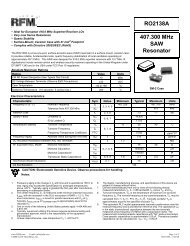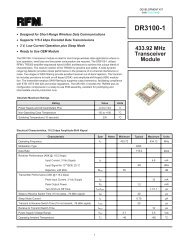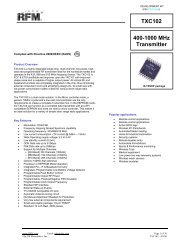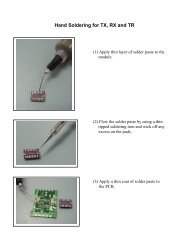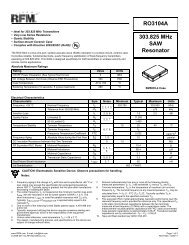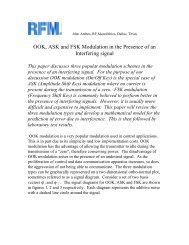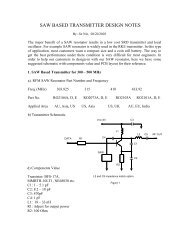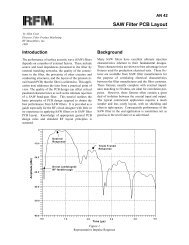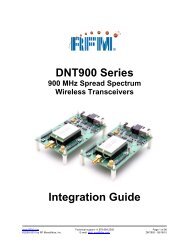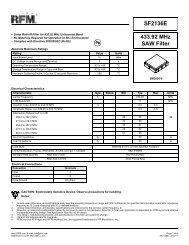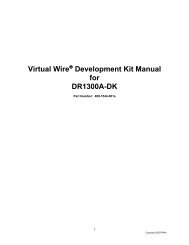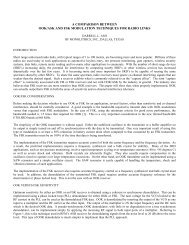TRC101 300-1000 MHz Transceiver - RF Monolithics, Inc.
TRC101 300-1000 MHz Transceiver - RF Monolithics, Inc.
TRC101 300-1000 MHz Transceiver - RF Monolithics, Inc.
Create successful ePaper yourself
Turn your PDF publications into a flip-book with our unique Google optimized e-Paper software.
The FIFO can be read out through the SDO pin only by pulling the nFSEL pin (6) ‘Low” which selects theFIFO for read and reading out data on the next SPI clock. The FINT pin (7) will stay active (logic ‘1’) untilthe last bit has been read out, and it will then go ‘low’. This pin may also be polled to watch for valid data.When the number of bits received in the FIFO match the pre-programmed limit, this pin will go active(logic ‘1’) and stay active until the last bit is read out as above. An alternative method of reading the FIFOis through an SPI bus Status Register read. The drawback to this is that all interrupt and status bits mustbe read first before the FIFO bits appear on the bus. This could pose a problem for receiving largeamounts of data. The best method is using the SDO pin and the associated FIFO function pins.Automatic Frequency Adjustment (AFA)The PLL has the capability to do fine adjustment of the carrier frequency automatically. In this way, thereceiver can minimize the offset between transmit and receive frequency. This function may be enabledor disabled through the Automatic Frequency Adjustment Register. The range of offset can beprogrammed as well as the offset value calculated and added to the frequency control word within thePLL to incrementally change the carrier frequency. The chip can be programmed to automaticallyperform an adjustment or may be manually activated by a strobe signal. This function has the advantageof allowing:• Low cost lower accuracy crystals to be used• <strong>Inc</strong>reased receiver sensitivity by narrowing the receive bandwidth• Achieving higher data ratesCrystal OscillatorThe <strong>TRC101</strong> incorporates an internal crystal oscillator circuit that provides a 10<strong>MHz</strong> reference, as well asinternal load capacitors. This significantly reduces the component count required. The internal loadcapacitance is programmable from 8.5pF to 16pF in 0.5pF steps. This has the advantage of accepting awide range of crystals from many different manufacturers having different load capacitance requirements.Being able to vary the load capacitance also helps with fine tuning the final carrier frequency since thecrystal is the PLL reference for the carrier.An external clock signal is also provided that may be used to run an external processor. This also hasthe advantage of reducing component count by eliminating an additional crystal for the host processor.The clock frequency is also programmable from eight pre-defined frequencies, each a pre-scaled value ofthe 10<strong>MHz</strong> crystal reference. These values are programmable through the Battery Detect Threshold andClock Output Register. The internal clock oscillator may be disabled which also disables the output clocksignal to the host processor. When the oscillator is disabled, the chip provides an additional 196 clockcycles before releasing the output, which may be used by the host processor to setup any functionsbefore going to sleep.Frequency Control (PLL) and Frequency SynthesizerThe PLL synthesizer is the heart of the operating frequency. It is programmable and completelyintegrated, providing all functions required to generate the carriers and tunability for each band. The PLLrequires only a single 10<strong>MHz</strong> crystal reference source. <strong>RF</strong> stability is controlled by choosing a crystalwith the particular specifications to satisfy the application. This gives the designer the maximum flexibilityin performance.The PLL is able to perform manual and automatic calibration to compensate for changes in temperatureor operating voltage. When changing band frequencies, re-calibration must be performed. This can bedone by disabling the synthesizer and re-enabling again through the Power Management Register.Registers common to the PLL are:• Power Management Register• Configuration Register• Frequency Setting Register• Automatic Frequency Adjust Register• Transmit Configuration RegisterData Quality Detector (DQD)www.<strong>RF</strong>M.com Email: info@rfm.com Page 9 of 42©by <strong>RF</strong> <strong>Monolithics</strong>, <strong>Inc</strong>. <strong>TRC101</strong> - 4/8/08



